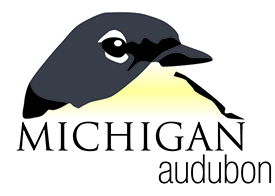Featuring: The Hooded Merganser
An extravagantly crested duck of North America
An extravagantly crested duck of North America
Hooded Merganser Breeding Grounds
This duck has both year-round grounds and breeding grounds in Michigan. The Hooded Merganser’s year-round grounds include most of lower Michigan; the breeding grounds include the tip of the Northern Lower Peninsula and all of the Upper Peninsula. It also has breeding grounds in Quebec, Ontario and Manitoba. The year-round range includes most of the states east of the Mississippi.
Michigan Audubon Sanctuaries where Hooded Merganser can be found:
- Brockway Mountain (Eagle Harbor, MI)
- Capital City Bird Sanctuary (Lansing, MI, opens Fall 2013)
- Davis Bog (Alpena, MI)
- Lake Bailey Sanctuary (Eagle Harbor, MI)
- Lake Bluff Bird Sanctuary (Manistee, MI)
- Little Lake Sanctuary (Paradise, MI)
- Margaret Shroyer Sanctuary (Paradise, MI)
- Martha Mott Sanctuary (Van Buren County, MI)
- Otis Farm Bird Sanctuary (Hastings, MI)
- Owashtanong Islands Sanctuary (Grand Haven, MI)
- Riverbank Sanctuary (Manistique, MI)
- Warner Sanctuary (Hastings, MI)
- Whitefish Point Bird Observatory(Paradise, MI)
Size & Shape
The Hooded Merganser is a small duck with a thin bill and wings and a long, rounded tail. The duck looks like it has an oversized head, although it is just a collapsible crest.
Coloring
Although both males and females display the eye catching crest their coloration differs between the two genders.
Male
He is black above with a white breast and chestnut flanks. The head and crest is black with a large white patch that changes in size as the crest rises and falls, but is always visible.
Female
She is a gray/brown color all over with cinnamon tones on her head. She does not have a patch on her crest but like the male’s, her crest changes in size as it rises and falls.
Habitat
Hooded Mergansers breed in forested wetland systems that include pine-hardwoods and cottonwood-elder riparian forests. Newly hatched ducklings and their mothers are often found foraging in shallow water such as marshes, small lakes, ponds, beaver wetlands, swamps and forested rivers. You may observe this merganser resting on exposed rocks, logs or sandbars.
Food
The Hooded Merganser eats the widest variety of food than any other merganser. They consume small fish, aquatic insects, crustaceans (especially crayfish), amphibians, vegetation and mollusks. They catch their prey by diving under the water using their feet to propel themselves and their slender bills to snatch prey. Their adaptive underwater sight also helps catch their prey. This merganser has an extra eyelid call a nictitating membrane which acts similarly to goggles, it is clear and helps protect the eyes during diving and swimming.
Behavior
As stated above they are superb divers. Their legs are located farther back on their bodies than most ducks which aids in diving but makes them slightly awkward on land. These ducks are usually found in small groups of 2-40 mergansers. Hooded Mergansers participate in “brood parasitism” which is similar to the parasitism of Brown-headed Cowbirds except they only lay their eggs in other Hooded Merganser nests.
Sound
The merganser is a rather secretive bird and only make a song or call during breeding season or to call their ducklings. The male courts the female with a deep, rolling croak sound, similar to a frog. The female responds by giving a hoarse gack call. When calling her duckling she will use a rough croo-croo-crook call, similar to sea ducks. Additionally, the mergansers wings make an interesting, rather loud,whirring sound during flight.
Mating
Hooded Mergansers court in groups of one or more females and several males. The male raises his crest to display the bright white patch and shakes his head. In a more elaborate display the male will throw his head back and touch his back with his crest and give off his frog like croak. If interested, the female will respond by bobbing her head and giving her hoarse gack. Males abandon their mates once the egg incubation starts.
Nests
Females choose the nest site in a pre-existing cavity in dead or alive trees typically close to water. The nest cavities are around 10-50 feet above the ground. They prefer cavities that already have materials in them and she will gradually start adding down from her belly after she lays the eggs. Hooded Mergansers are also prone to using nest boxes as long as they are the appropriate size. Cornell Lab provides construction plans for nest boxes for these birds.
Conservation Status
Least Concern. The largest population numbers occur in the Great Lakes Region, populations are stable and/or slightly increasing. The merganser has dealt with major habitat loss in the past but has recovered nicely.
Interesting Facts
- According to Cornell Lab, “Female Hooded Mergansers can lay up to about 13 eggs in a clutch, but nests have been found with up to 44 eggs in them” due to brood parasitism.
- Hooded Merganser ducklings leave their nest within 24 hours of hatching.
- The Hooded Merganser is the second-smallest merganser of the six living species and the only one restricted to North America.
Your Bird Crew,



No comments:
Post a Comment